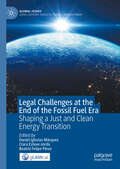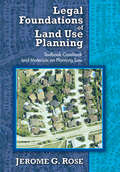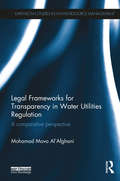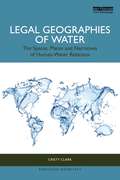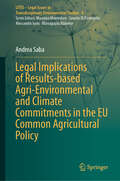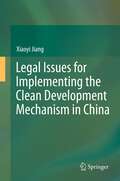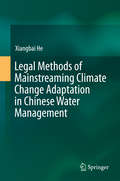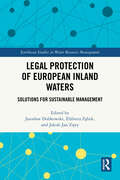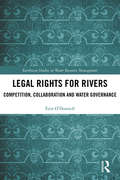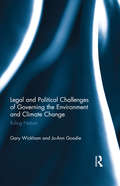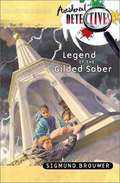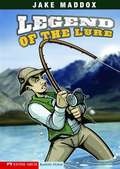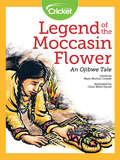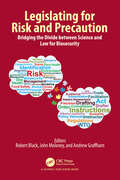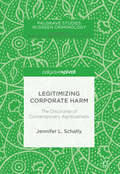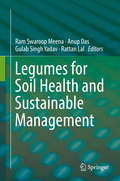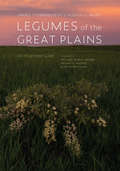- Table View
- List View
Legal Challenges at the End of the Fossil Fuel Era: Shaping a Just and Clean Energy Transition (Global Issues)
by Daniel Iglesias Márquez Clara Esteve-Jordà Beatriz Felipe PérezThis edited collection proposes a wide range of approaches to address the legal issues pertaining to the end of the fossil fuel era. While the fossil fuel era is coming to an end both because of the inherent limits of its resources and because of the need to prevent to further pump out CO2 in an already saturated atmosphere, the legal dispositions to ensure an ordered and rational shift toward cleaner energy still need to be developed. Not only in relation to CO2 emissions themselves but also in relation to the manifold issues related to environmental justice in an era of global climate change and global warming. This book is unique in that it provides a theoretical framework but also works to address cutting edge issues through a series of case studies.
Legal Design for Social-Ecological Resilience
by Brita BohmanTheories of social-ecological resilience have developed over the past decades and rapidly become an important framework for governance of complex non-linear environmental problems. This book explores the resilience theories and their compatibility with law, it identifies corresponding legal features. The legal features identified, including legal measures, mechanisms, principles and approaches, form a legal design for social-ecological resilience. A legal design that can be applied to different governance situations. It can be a tool both for designing new laws, as well as for assessing the effectiveness of current laws and legal systems. In many ways environmental law has adjusted and developed new approaches to meet complex environmental problems, but law is still challenged by the complexity that characterize environmental problems and the environmental change connected with the Anthropocene. This book provides a comprehensive review of the most fundamental components of the governance framework for social-ecological resilience and the role of law.
Legal Foundations of Land Use Planning: Textbook-Casebook and Materials on Planning Law
by Jerome G. RoseUrban planning is a community process, the purpose of which is to develop and implement a plan for achieving community goals and objectives. In this process, planners employ a variety of disciplines, including law. However, the law is only an instrument of urban planning, and cannot solve all urban problems or meet all social needs. The ability of the legal system to implement the planning process is limited by philosophical, historical, and constitutional constraints. Jurisprudence is concerned with societal values and relationships that limit the effectiveness of the law as an instrument of urban planning. When law is definite and certain, freedom is enhanced within the boundaries created by the law. This doctrine of Anglo-American law imposes an obligation on courts to be guided by prior judicial decision or precedents and, when deciding similar matters, to follow the previously established rule unless the case is distinguishable due to facts or changed social, political, or economic conditions The author focuses on seven specific areas of law in relation to land use planning: law as an instrument of planning, zoning, exclusionary zoning and managed growth, subdivision regulations, site plan review and planned unit development, eminent domain, and the transfer of development rights. Jerome G. Rose cites more than one hundred court cases, and the indexed list serves as a useful encyclopedia of land use law. This is a valuable sourcebook for all legal experts, urban planners, and government officials.
Legal Frameworks for Transparency in Water Utilities Regulation: A comparative perspective (Earthscan Studies in Water Resource Management)
by Mohamad Mova Al'AfghaniTransparency in the regulation of water utilities is essential in order to ensure quality and fairness. This book explores and compares different regulatory arrangements in the water utilities sectors in three jurisdictions to determine which regulatory and ownership model is most transparent and why. The three jurisdictions considered are England (UK), Victoria (Australia) and Jakarta (Indonesia). Following an introduction to the importance of transparency in water utilities regulation, the book provides an overview of the three chosen jurisdictions and their legal and institutional frameworks. Through a comparison of these the author explores the contested and difficult terrain of "privatization", as (often) opposed to public ownership, in which it is shown that the relationships between transparency and ownership models are not as clear-cut as might be assumed. Chapters consider various aspects and outcomes of the regulatory process and the role of transparency, including topics such as regulators' internal governance mechanisms, utilities corporate governance, licensing and information flow, freedom of information and transparency in tariffs and pricing, as well as customer service. The book concludes with a summary of lessons learned to inform the refinement of transparency in utilities regulation.
Legal Geographies of Water: The Spaces, Places and Narratives of Human-Water Relations (Earthscan Water Text)
by Cristy ClarkThis book deepens our understanding of humanity’s diverse relationships with water and the law, providing a critical assessment of this relationship, and charting the course towards a more sustainable and just water future.By using legal geography, this book pays particular attention to the place-based inter-relationships between water, people, and law (both formal and informal) and to the ways that law both constitutes and is constituted by the relationship between people and place. Starting in the 1980s, Chapter 2 investigates the early commodification of water through the liberalisation of rural water markets in Chile and the urban water supply and sanitation systems of England and Wales. Chapter 3 then examines the global expansion of neoliberal water governance in the 1990s, starting with donor-driven reforms in the global south and particularly Manila in the Philippines. Chapters 4 and 5 document both the grassroots response to these neoliberal water reforms and the inherent tensions in the attempts of the early 2000s to reconcile the recognition of a human right to water with the ongoing rollout of market mechanisms, both in the domestic context of South Africa and within the United Nations human rights system. Moving forward again, Chapter 6 examines the recent intensification of neoliberal water governance through financialisation and considers its specific impacts in Detroit and Flint, Michigan. Chapter 7 then considers the renewed global emphasis on living waters and Indigenous ontologies of water by examining the new legislative arrangements for the Whanganui River in Aotearoa, New Zealand. The book concludes in Chapter 8 by highlighting the stories of hope that can be found in many of the case studies explored in the book and in emerging examples from around the world.This book is essential reading for students and scholars interested in water law, security, and justice from across a wide range of disciplines, including environmental studies, law, geography, human rights, and political ecology.
Legal Implications of Results-based Agri-Environmental and Climate Commitments in the EU Common Agricultural Policy (LITES - Legal Issues in Transdisciplinary Environmental Studies #4)
by Andrea SabaThis book offers essential insights into the policy and legal implications of the results-based approach in terms of shaping recent agri-environmental and climate commitments in the European Union and encouraging farmers to deliver significant and quantifiable enhancements of the quality of the environment within the EU Common Agricultural Policy. To do so, it addresses several cutting-edge questions: what is the current legal understanding of ecosystem services in the European Union? How has the ecosystem-based approach and its linkage with the multifunctional role of agriculture been recognised in EU agricultural law? How have agri-environmental and climate schemes evolved to adopt the results-based approach? To what extent is the Common Agricultural Policy’s new model encouraging farmers to deliver significant and quantifiable enhancements of the quality of the environment? What is the impact of the Common Agricultural Policy on EU actions concerning ecosystem and nature restoration? And lastly, what is the role of digitalisation and the AKIS in enhancing results-based agri-environmental and climate commitments in the EU? Given its scope, the book will be of interest to a wide readership of researchers, practitioners, professionals, students, and policymakers interested in agricultural law, rural development studies, ecosystem-based management, climate change, environmental studies, political science, and economics.
Legal Instruments for Sustainable Soil Management in Africa (International Yearbook of Soil Law and Policy)
by Harald Ginzky Oliver C. Ruppel Emmanuel Kasimbazi Hadijah Yahyah Robert KibugiThis book presents an important discussion on future options for sustainable soil management in Africa from various perspectives, including national soil protection regulations, the role of tenure rights, the work of relevant international institutions such as the UNCCD and FAO, and regional and international cooperation. This first volume of the new subseries Regional Perspectives to the International Yearbook of Soil Law and Policy includes contributions by African and international experts alike. Given the range of key topics covered, the book offers an indispensable tool for all academics, legislators and policymakers working in this field. The “International Yearbook of Soil Law and Policy – Regional Perspectives” series discusses central questions in law and politics that concern the protection and sustainable management of soil and land in different regions of the world.
Legal Issues for Implementing the Clean Development Mechanism in China
by Xiaoyi JiangToday, climate change is among the most hotly-debated topics. The Clean Development Mechanism (CDM), one of the three financial mechanisms under the Kyoto Protocol open to developing and developed countries, was devised to assist in mitigation of global warming. This book discusses what China should do to make full use of the CDM to promote sustainable development and to meet the challenge of climate change from a legal perspective. The findings lead to the conclusion that the CDM has limitations in promoting sustainable development in China, and thus should be regarded only as a complementary instrument in combating climate change. Legal strategies for improving the implementation of CDM projects under the legal framework in China are thus put forward, and some proposals for China to meet the challenge of climate change in the post-2012 era are made. This book offers new insights to academics and policymakers both in the public and private sector. It is intended for legal practitioners and researchers on carbon trading as well as policymakers interested in the role of developing countries in climate change law. In addition, it is of interest to stakeholders of CDM projects.
Legal Issues on Climate Change and International Trade Law
by Deok-Young ParkThis book provides anexcellent overview of the legal issues surrounding climate change mitigationand international trade law. It surveys key observed and potential challengesposed by responses to climate change in terms of international trade law. By examiningthe controversial issues seen in legal cases in which domestic climate changeor renewable energy measures conflicted with international trade regimes, thisvolume promotes and broadens the understanding and debate of the issues. Beyondthe recognized challenges, this book uncovers potential areas of conflictbetween climate change responses and international trade promotion by exploringprevious cases and current efforts to prevent climate change. Furthermore, thisvolume sheds light on the future direction of international trade law andclimate change responses, pointing out that the development of climate changeor renewable energy laws and policies must also consider international traderegimes in order to ensure the smooth implementation of said laws and policiesand guarantee that international trade laws do not restrict environmentalpolicy space.
Legal Liabilities in Safety and Loss Prevention: A Practical Guide, Third Edition (Occupational Safety & Health Guide Series)
by Thomas D. SchneidThe goal of every safety professional and safety program is to be proactive and to identify problems while complying within safety guidelines. This book clarifies basic questions about legal liability, how to minimize, prevent, and identify legal risks. Appendices, case studies, and sample forms are included in this resource. The whole book will be revised due to the laws and regulations in the workplace changing. This revised edition will address all of the changes in the laws as well as providing guidance on how to achieve and maintain compliance. Features Covers methods to achieve and maintain compliance Includes new standards and regulations Discusses defense, rights, and responsibilities Provides a guide to professionals who are unfamiliar with reviewing, analyzing, and briefing a court decision Offers a new chapter on environmental and labor
Legal Methods of Mainstreaming Climate Change Adaptation in Chinese Water Management
by Xiangbai HeThis book addresses why, whether and how the existing legal framework on water management in China could make climate change adaptation a mainstream issue. The book uses a table to illustrate the distinctions and similarities between IWRM and water-centered adaptation to analyze the possibilities of mainstreaming adaptation. The new water-planning processes and EIA are also illustrated in the form of figures showing the differences after factoring in adaptation considerations. Interviews with water managers to obtain their perception and attitudes towards climate change adaptation offer new perspectives for readers. The adaptation- mainstreaming approach, which finds a way to balance various interests and tasks, will arouse the interests of those readers who argue that climate change is only one of the issues challenging water management, and that poverty reduction, environmental protection and living standard improvement are even more important. Readers will also be interested to discover that the adaptation mainstreaming approach could be applied in water management institutions such as water planning and EIA. In addition, the book offers a clear explanation of the challenges of adaptation to the existing water-related legal framework from a theoretical perspective, and provides theoretical and practical recommendations.
Legal Pathways to Deep Decarbonization in the United States
by Michael B. Gerrard; John C. DernbachLegal Pathways to Deep Decarbonization in the United States provides a “legal playbook” for deep decarbonization in the United States, identifying well over 1,000 legal options for enabling the United States to address one of the greatest problems facing this country and the rest of humanity. <p><p> The book is based on two reports by the Deep Decarbonization Pathways Project (DDPP) that explain technical and policy pathways for reducing U.S. greenhouse gas emissions by at least 80% from 1990 levels by 2050. This 80x50 target and similarly aggressive carbon abatement goals are often referred to as deep decarbonization, distinguished because it requires systemic changes to the energy economy. <p> Legal Pathways explains the DDPP reports and then addresses in detail 35 different topics in as many chapters. These 35 chapters cover energy efficiency, conservation, and fuel switching; electricity decarbonization; fuel decarbonization; carbon capture and negative emissions; non-carbon dioxide climate pollutants; and a variety of cross-cutting issues. The legal options involve federal, state, and local law, as well as private governance. Authors were asked to include all options, even if they do not now seem politically realistic or likely, giving Legal Pathways not just immediate value, but also value over time. <p> While both the scale and complexity of deep decarbonization are enormous, this book has a simple message: deep decarbonization is achievable in the United States using laws that exist or could be enacted. These legal tools can be used with significant economic, social, environmental, and national security benefits.
Legal Protection of European Inland Waters: Solutions for Sustainable Management (Earthscan Studies in Water Resource Management)
by Jarosław Dobkowski Elżbieta Zębek Jakub Jan ZiętyThis book examines the legal protection and management of inland waters in Europe.With inland waters facing a range of significant threats, including from climate change, pollution, and overexploitation, this volume discusses legal solutions for protecting and managing these inland waters. It presents comparative studies from a range of European countries, including the Czech Republic, Germany, France, Lithuania, Poland, and Spain, with each chapter examining the legal status and legal instruments being implemented in each country, allowing for easy cross-comparison. Topics covered include surface water management and protection, water quality and monitoring, management of hazardous substances, and crisis management. Through these unique comparative studies, the volume highlights legal solutions which can be adopted by other nations and used as models for wider implementation across Europe. In doing so, this book offers important recommendations for changing water law to ensure a water secure future in Europe.This book will be of great interest to students and scholars of water law, water resource management, environmental policy, and environmental conservation.
Legal Rights for Rivers: Competition, Collaboration and Water Governance (Earthscan Studies in Water Resource Management)
by Erin O'DonnellIn 2017 four rivers in Aotearoa New Zealand, India, and Colombia were given the status of legal persons, and there was a recent attempt to extend these rights to the Colorado River in the USA. Understanding the implications of creating legal rights for rivers is an urgent challenge for both water resource management and environmental law. Giving rivers legal rights means the law can see rivers as legal persons, thus creating new legal rights which can then be enforced. When rivers are legally people, does that encourage collaboration and partnership between humans and rivers, or establish rivers as another competitor for scarce resources? To assess what it means to give rivers legal rights and legal personality, this book examines the form and function of environmental water managers (EWMs). These organisations have legal personality, and have been active in water resource management for over two decades. EWMs operate by acquiring water rights from irrigators in rivers where there is insufficient water to maintain ecological health. EWMs can compete with farmers for access to water, but they can also strengthen collaboration between traditionally divergent users of the aquatic environment, such as environmentalists, recreational fishers, hunters, farmers, and hydropower. This book explores how EWMs use the opportunities created by giving nature legal rights, such as the ability to participate in markets, enter contracts, hold property, and enforce those rights in court. However, examination of the EWMs unearths a crucial and unexpected paradox: giving legal rights to nature may increase its legal power, but in doing so it can weaken community support for protecting the environment in the first place. The book develops a new conceptual framework to identify the multiple constructions of the environment in law, and how these constructions can interact to generate these unexpected outcomes. It explores EWMs in the USA and Australia as examples, and assesses the implications of creating legal rights for rivers for water governance. Lessons from the EWMs, as well as early lessons from the new ‘river persons,’ show how to use the law to improve river protection and how to begin to mitigate the problems of the paradox.
Legal and Political Challenges of Governing the Environment and Climate Change: Ruling Nature
by Gary Wickham Jo-Ann GoodieThe environment has not always been protected by law. It was not until the middle of the 20th century that ‘the environment’ came to be understood as an entity in need of special care, and the law-politics duo firmly fixed its focus on this issue. In this book Wickham and Goodie tell the story of how law and politics first came upon the environment as an object in need of special attention. They outline the unlikely intersection of aesthetics and science that made ‘the environment’ into the matter of great concern it is today. The book describes the way private common-law strategies and public-law legislative strategies have approached the task of protecting the environment, and explore the greatest environmental challenge to have so far confronted environmental law and politics; the threat of global climate change. The book offers descriptions of many of the strategies being deployed to meet this challenge and present some troubling assessments of them. The book will be of great interest to students, teachers, and researchers of environmental law, socio-legal studies, environmental studies, and political theory.
Legally Poisoned: How the Law Puts Us at Risk from Toxicants
by Carl F. CranorTake a random walk through your life and you’ll find it is awash in industrial, often toxic, chemicals. Sip water from a plastic bottle and ingest bisphenol A. Prepare dinner in a non-stick frying pan or wear a layer of Gore-Tex only to be exposed to perfluorinated compounds. Hang curtains, clip your baby into a car seat, watch television—all are manufactured with brominated flame-retardants. Cosmetic ingredients, industrial chemicals, pesticides, and other compounds enter our bodies and remain briefly or permanently. Far too many suspected toxic hazards are unleashed every day that affect the development and function of our brain, immune system, reproductive organs, or hormones. But no public health law requires product testing of most chemical compounds before they enter the market. If products are deemed dangerous, toxicants must be forcibly reduced or removed—but only after harm has been done. In this scientifically rigorous legal analysis, Carl Cranor argues that just as pharmaceuticals and pesticides cannot be sold without pre-market testing, other chemical products should be subject to the same safety measures. Cranor shows, in terrifying detail, what risks we run, and that it is entirely possible to design a less dangerous commercial world.
Legend of the Gilded Saber (Accidental Detectives #3)
by Sigmund BrouwerAccidental DETECTIVES THE SECRETS HE IS HIDING MAY DESTROY HIS LIFE . . . . When RICKY KIDD and his friends Lisa, Ralphy, and Mike go to visit Mike's uncle Ted Emmett for a week, it seems like a great opportunity to explore Charleston, South Carolina, and learn more about that fascinating city and its history. But when Mr. Emmett is arrested for theft their first morning in town, everything is turned upside down. All of the evidence seems to point to Ted Emmett's guilt, but the Accidental Detectives are sure he is innocent. However, unless they can prove that someone framed him, Mike's uncle will be spending the rest of his life--however long that may be--in prison. WHAT SECRETS IS MIKE'S UNCLE HIDING? WHO REALLY STOLE THE GILDED SABER--AND WHY? WHO CAN THE ACCIDENTAL DETECTIVES TRUST?
Legend of the Lure
by Jake MaddoxDaniel has always heard stories about Big Larry, and when his grandpa dies, he is determined to catch the big fish.
Legend of the Moccasin Flower: An Ojibwe Tale
by Mary Morton CowanWhite Rabbit, an Ojibwe Native American, helplessly watches as her village begins to suffer from a deadly winter disease. When her brother Running Wolf falls ill, she plans to bring back more healing herbs from a neighboring village. When White Rabbit races through the snow, she ends up leaving behind a new flower that appears in the spring.
Legendary Locals of Yosemite National Park and Mariposa County (Legendary Locals)
by Leroy RadanovichIn 1846, Thomas Larkin, American council general to the Mexican government in California, purchased a Mexican land grant, Las Mariposas, for Col. John C. Fremont. The grant consisted of 10 square leagues of grazing land located near the Merced River and west of the Sierra. In 1848, when California became the possession of the United States, the treaty called for the recognition of preexisting grants. Gold was discovered in the foothills of the Sierra that same year. Fremont floated his questionable Mexican grant into the gold discovery region. With the formation of the State of California in 1850, one of the original counties was named Mariposa, Spanish for "butterflies." Located within the county was the Fremont grant and much of the yet undiscovered Yosemite region of the Sierra. Encounters with Native Americans near the mining camps lead to the formation of the Mariposa Battalion, and a search for the natives led to the American discovery of Yosemite Valley. Thus, it was custodians and photographers such as Charles Leander Weed, Carlton E Watkins, J.J. Riley, George Fiske, Ansel Adams, and many others that interpreted and introduced Yosemite to the world.
Legislating for Risk and Precaution: Bridging the Divide between Science and Law for Biosecurity
by Robert Black John Moloney Andrew GraffhamThis book aims to demystify the law for scientists and instructing officials by exploring the science and legal concepts of risk and precaution for national legislation to facilitate safe trade in agricultural products (in compliance with international trade rules).The book is not meant to supplant the many authoritative titles on legislative drafting, but provide some practical exercises on instructions and drafting for this area of law. The book also includes some important factors in legal reform, such as the audience for and access to legislation. It, therefore, has the potential to be a valuable resource for coordinated training of instructors and drafters by helping to secure a robust two-way dialogue between them.
Legitimizing Corporate Harm
by Jennifer L. SchallyThis book utilizes critical discourse analysis to illuminate the ways in which one of the largest agribusinesses in operation, Tyson Foods, disguises their actions whilst simultaneously presenting the image of a benign, good corporate citizen. Schally unveils how the discourses employed by Tyson gain legitimacy by drawing on and aligning with larger cultural discourses that are often taken for granted and not adequately scrutinised. This original research, situated at the intersection of green and cultural criminologies, contributes to these current perspectives as well as to the burgeoning social harm approach within criminology. A bold and engaging study, this book will be indispensable for students and scholars of green criminology, corporate crime, animals and society, and environmental sociology, as well as environmental and animal rights activists.
Legume Crop Wild Relatives: Their Role in Improving Climate Resilient Legumes
by Harsh Nayyar Uday Chand Jha Kamal Dev Sharma Bishop von Wettberg, Eric J Siddique, Kadambot H. M.Grain legume crops are an important component of global food and nutritional security and help in maintaining agro-ecological systems. They fix atmospheric nitrogen via the root-inhabiting rhizobacteria, thereby minimising the harmful effects caused by the excessive application of synthetic nitrogenous fertilizers in the soil environment. There has been less focus on legume crop wild relatives for harnessing their potential traits and novel gene(s) to incorporate them into the cultivated legumes for developing climate-resilient grain legumes. In this edited book, we will highlight the importance of various potential traits of crop wild relatives, which are yet to be properly harnessed for designing future climate-resilient grain legumes. We also update how advances in molecular genetics and genomics have enabled the underpinning of several candidate genes/genomic regions in various crop wild relatives harbouring adaptive traits that confer climate resilience in grain legumes.Readers will benefit from new information on various crop wild relatives in grain legumes and how these wild relatives could be explored for novel climate resilience genes for developing future climate-resilient legume crops. They will gain an understanding of how genomic advances (genome sequence, pan genomes) have uncovered the novel genomic regions attributed to climate resilience in various grain legumes. Finally, the critical role of these wild relatives in maintaining the lost gene(s) due to the domestication process will be discussed.Comprehensive information on conventional breeding, advanced breeding, and recent advances in genomics covering all the major crop wild relatives of legumes is not available in a single book. Thus, this book will provide readers with the latest updates on various information covering all aspects of wild species of legumes.
Legumes for Soil Health and Sustainable Management
by Rattan Lal Ram Swaroop Meena Anup Das Gulab Singh YadavSustainable management of soils is an important global issue of the 21st century. Feeding roughly 8 billion people with an environmentally sustainable production system is a major challenge, especially considering the fact that 10% of the world’s population at risk of hunger and 25% at risk of malnutrition. Accordingly, the 68th United Nations (UN) general assembly declared 2016 the “International Year of Pulses” to raise awareness and to celebrate the role of pulses in human nutrition and welfare. Likewise, the assembly declared the year 2015 as the “International Year of Soils” to promote awareness of the role of “healthy soils for a healthy life” and the International Union of Soil Science (IUSS) has declared 2015-2024 as the International Decade of Soils. Including legumes in cropping systems is an important toward advancing soil sustainability, food and nutritional security without compromising soil quality or its production potential. Several textbooks and edited volumes are currently available on general soil fertility or on legumes but‚ to date‚ none have been dedicated to the study of “Legumes for Soil Health and Sustainable Management”. This is important aspect, as the soil, the epidermis of the Earth (geoderma)‚ is the major component of the terrestrial biosphere. This book explores the impacts of legumes on soil health and sustainability, structure and functioning of agro-ecosystems, agronomic productivity and food security, BNF, microbial transformation of soil N and P, plant-growth-promoting rhizobacteria, biofertilizers, etc. With the advent of fertilizers, legumes have been sidelined since World War II, which has produced serious consequences for soils and the environment alike. Therefore, legume-based rational cropping/soil management practices must support environmentally and economically sustainable agroecosystems based on (sequential) rotation and intercropping considerations to restore soil health and sustainability. All chapters are amply illustrated with appropriately placed data, tables, figures, and photographs, and supported with extensive and cutting-edge references. The editors have provided a roadmap for the sustainable development of legumes for food and nutritional security and soil sustainability in agricultural systems, offering a unique resource for teachers, researchers, and policymakers, as well as undergraduate and graduate students of soil science, agronomy, ecology, and the environmental sciences.
Legumes of the Great Plains: An Illustrated Guide
by James Stubbendieck Jessica L. MilbyLegumes of the Great Plains: An Illustrated Guide is an invaluable tool for the identification of more than 114 species of legumes in the Great Plains. In addition to a distribution map, botanical illustration, and an in-depth botanical description, this comprehensive guide describes the habitat, uses and values, pollinators, forage value for livestock and wildlife, toxic properties, and ethnobotany of each species. The botanical synonyms and other common names—including those used by the Great Plains Indians—are also provided. This volume includes more than one hundred similar species with a description of how each differs from the main species. This reference book is indispensable to anyone interested in grassland and prairie conservation and management, the Great Plains, botany, or modern taxonomy.
